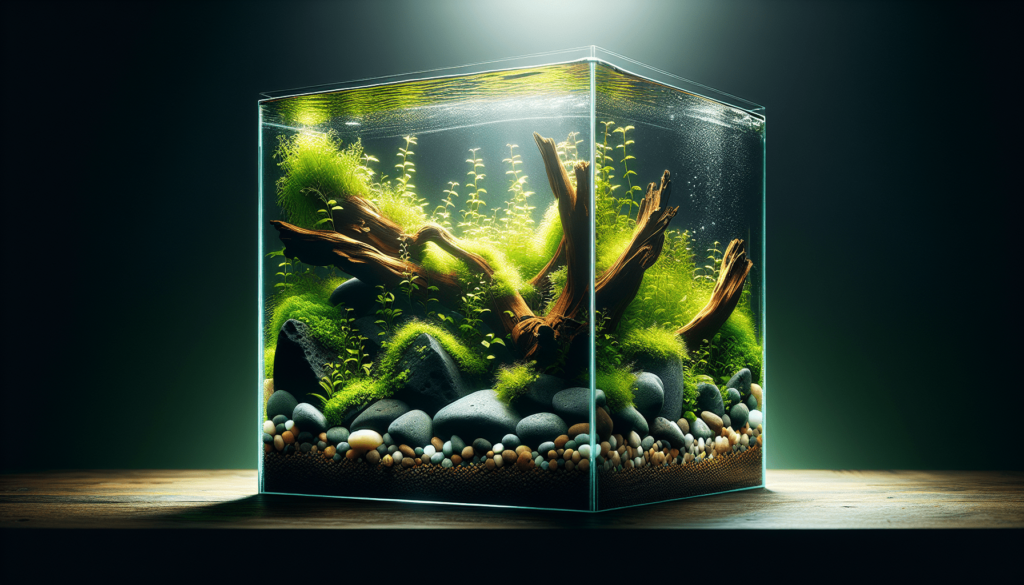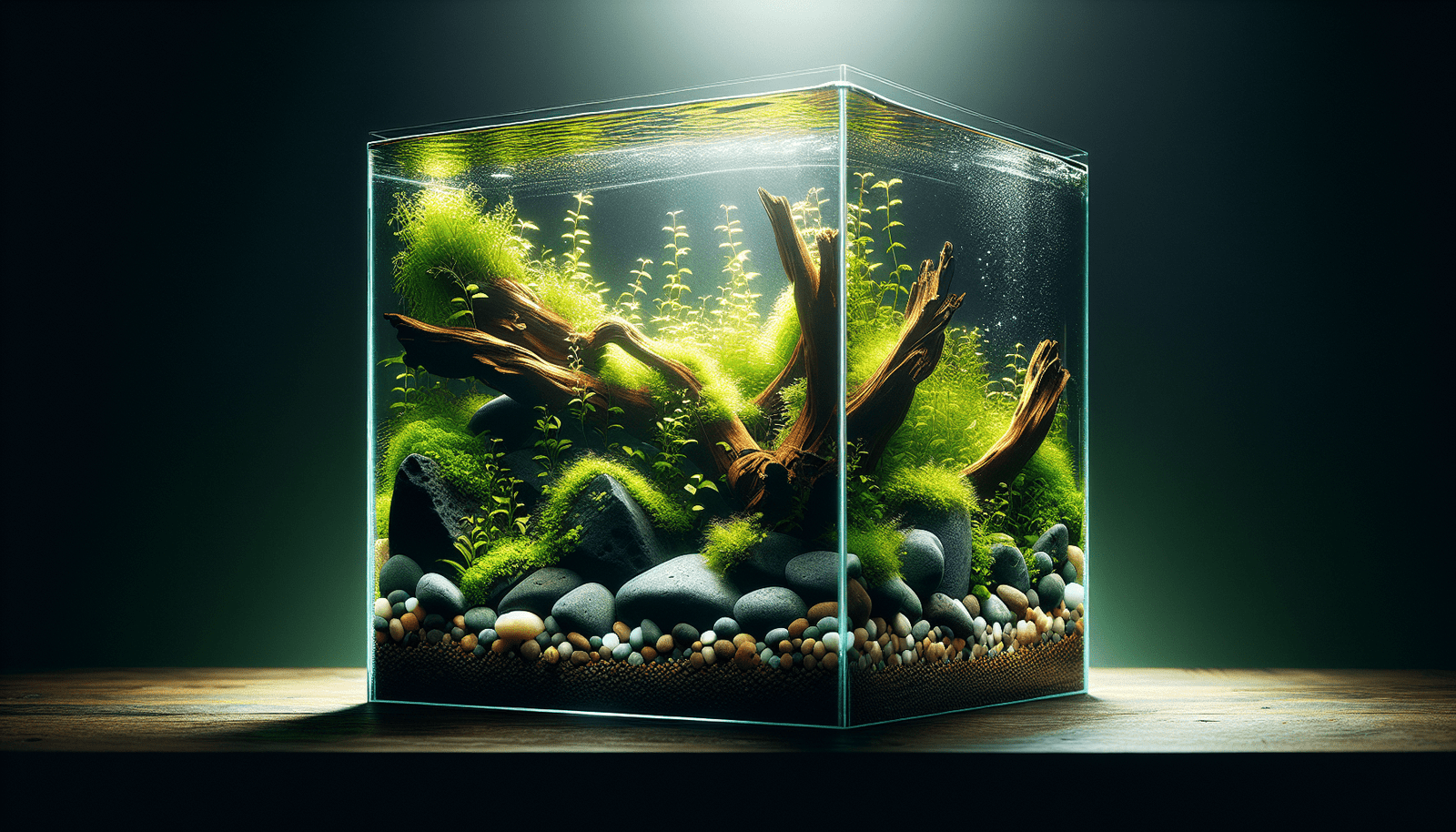Can you imagine creating a beautiful underwater garden inside a small glass box? That’s what cube aquascaping is all about! If you’re excited about learning how to make your own mini-aquarium masterpiece, then you’re in the right place. This guide will take you from being a newbie to becoming an aquascaping artist.
Overview: What’s Cube Aquascaping?
Cube aquascaping is like gardening, but underwater. You design and arrange plants, rocks, and other elements to create a tiny, beautiful landscape inside a cube-shaped tank. It’s like having a piece of nature right in your room. It’s popular because it combines creativity, nature, and even some science. Plus, it’s super fun and relaxing!
The Main Idea: Why Is Cube Aquascaping Important?
Creating a cube aquascape isn’t just about making something nice to look at; it’s about understanding the environment and creating a balanced ecosystem. This means your small aquarium will not only look pretty but also be a healthy place for fish and plants to live. By learning the essentials of cube aquascaping, you’ll be able to bring a bit of nature indoors and even help take care of the environment.

A Little History: Where Did Cube Aquascaping Start?
Aquascaping as an art form has been around for a long time, but cube aquascaping became popular more recently. People were inspired by Japanese aquariums where balance and natural beauty are key. Japanese aquarium artist Takashi Amano made this hobby famous worldwide. He showed that you don’t need a huge tank to make an amazing aquascape. Even a small cube can be a work of art.
Current Trends: What’s Popular in Cube Aquascaping Today?
Nowadays, many people are into natural-looking aquascapes. They like to use real plants, rocks, and driftwood to make their aquariums look like a small slice of a real forest or riverbed. Sustainable and eco-friendly materials are also becoming popular. People are even using LED lights to mimic natural sunlight and make their plants grow better.

Key Concepts and Definitions: What Do You Need to Know?
Before you start creating your cube aquascape, it’s helpful to understand some key terms:
- Substrate: This is the material that sits at the bottom of your tank. It can be sand, gravel, or special soil made for growing aquatic plants.
- Hardscape: These are the non-living elements like rocks, driftwood, and decorations that you use to design your landscape.
- Filtration: This helps keep your tank’s water clean and healthy for fish and plants.
- Lighting: Plants need light to grow, so having the right kind of lighting is important.
- CO2 (Carbon Dioxide): Just like plants on land, underwater plants need CO2 to thrive. Sometimes people add CO2 to their tanks to help plants grow.
Getting Started: Steps to Create Your Cube Aquascape
Step 1: Plan Your Design
Think about what kind of landscape you want to create. Do you want a forest, a mountain, or maybe a riverbed? Sketch your ideas or look for inspiration online.
Step 2: Choose Your Tank
Pick a cube-shaped tank. They come in different sizes, but a good starting point is a 10-gallon tank.
Step 3: Select Your Substrate
Choose the right substrate based on the plants you want to grow. If you’re using live plants, special aquatic soil can help them thrive.
Step 4: Build Your Hardscape
Arrange your rocks, driftwood, and other decorations. Think about how everything fits together, and try to make it look natural. This is like building the skeleton of your landscape.
Step 5: Planting
Choose low-maintenance plants if you’re a beginner. Place taller plants at the back and shorter plants at the front to create depth. Be careful when planting so you don’t damage the roots.
Step 6: Fill the Tank with Water
Slowly add water to your tank. Pouring water onto a rock or a plate can help avoid disturbing your substrate and plants.
Step 7: Install Your Equipment
Set up your filtration system, CO2 system (if using), and lighting. Make sure everything is working properly.
Step 8: Add Fish (Optional)
If you want fish, choose species that are small and suitable for your cube tank. Add them only after the water conditions are stable and the plants have started to grow.

Example 1: The “Forest” Aquascape
Imagine creating a tiny forest inside your cube tank! First, you would use a dark substrate to look like forest soil. Next, you might place driftwood pieces to resemble tree trunks and branches. For plants, you could use taller, bushy plants at the back to look like trees and smaller, carpet-like plants at the front to look like forest groundcover.
What You’ll Need:
- Dark aquatic soil
- Driftwood pieces
- Tall bushy plants (like Java Fern)
- Carpet plants (like Dwarf Hairgrass)
Steps:
- Prepare the tank and add the substrate.
- Arrange the driftwood to look like trees.
- Plant the tall plants at the back and the carpet plants in the front.
- Fill the tank with water gently.
- Install your equipment and check everything is working.
- Optional: Add small fish like Neon Tetras once the plants are settled.
Example 2: The “Mountain” Aquascape
If you’d rather have a rocky mountain scene, here’s how you can do it. Use large rocks to create the peaks and slopes, and add smaller stones to mimic boulders. You can use low-growing plants to resemble grass and moss to add that wild, untamed look.
What You’ll Need:
- Sand or fine gravel substrate
- Large and small rocks
- Low-growing plants (like Anubias)
- Moss (like Java Moss)
Steps:
- Set up the tank and add the substrate.
- Arrange the large rocks to form mountain shapes.
- Place smaller rocks to add detail.
- Plant the low-growing plants around the rocks.
- Add water carefully.
- Set up all the equipment and make sure it’s working correctly.
- Optional: Add tiny fish species like a few Shrimp.
Different Perspectives: How Do Others Approach Cube Aquascaping?
Some people see cube aquascaping as an art project, focusing mostly on how beautiful they can make their tank look. Others are more interested in the science behind it, making sure everything in their tank, from the water chemistry to plant health, is perfect. There are also those who see it as a way to learn about and appreciate nature.
| Approach | Focus | Benefits |
|---|---|---|
| Art | Visual beauty and aesthetics | Stunning displays, creative outlet |
| Science | Water chemistry, plant health, and system balance | Healthy ecosystems, educational |
| Nature Appreciation | Learning about aquatic life and ecosystems | Deeper understanding of nature |
Impact: Why Does It Matter to Choose a Good Approach?
Your approach can affect not only how your aquascape looks but also how healthy it is for both plants and fish. For example, focusing too much on looks might make you overlook important details like water filtration or plant needs, leading to problems down the line. A balanced approach helps you create a cube aquascape that is not only beautiful but also sustainable.
Future Directions and Implications
Predictions: What’s Next in Cube Aquascaping?
As technology grows, so will cube aquascaping. We can expect better, more efficient equipment to help maintain small tanks. Advanced LED lights that mimic natural sunlight more closely, smart systems to monitor water quality, and eco-friendly products are already starting to appear.
Implications: Why Is This Important for You?
With better tools and products, more people can create amazing cube aquascapes. This makes the hobby more accessible and enjoyable. Plus, learning about ecosystems and caring for them can help you appreciate nature more and might even spark an interest in environmental conservation.
Conclusion
Cube aquascaping is an amazing way to combine art, science, and nature. It allows you to create beautiful underwater landscapes that are healthy and balanced. From choosing the right tank and materials to setting up your plants and equipment, each step is a chance to learn and be creative.
By understanding the different approaches and keeping an eye on future trends, you can not only create but also maintain a beautiful and thriving nano-aquarium. So why not give it a try and see what kind of underwater garden you can create?
Final Thought
What kind of mini-world will you create in your cube aquascape? Think about it, gather your materials, and start your journey!
Credible Sources
- Amano, T. (2011). Nature Aquarium: Complete Works 1985-2009. Aqua Design Amano Co., Ltd.
- Barr, T. (2008). The Estimative Index of Dosing. Aquatic Plant Central.
- Senske, J. (2017). The Planted Tank Handbook. Aquarium Co-Op.



